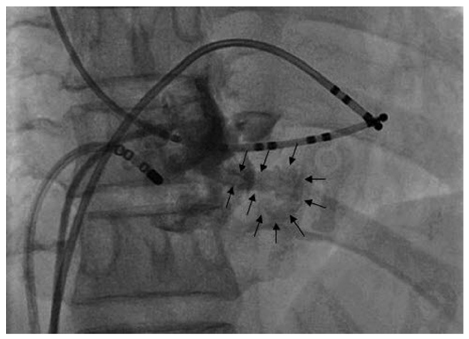Korean Circ J.
2009 Sep;39(9):389-391. 10.4070/kcj.2009.39.9.389.
Successful Radiofrequency Catheter Ablation for Wolff-Parkinson-White Syndrome Within the Neck of a Coronary Sinus Diverticulum
- Affiliations
-
- 1Division of Cardiology, Department of Internal Medicine, The Catholic University of Korea College of Medicine, Seoul, Korea. tairho@catholic.ac.kr
- KMID: 2225677
- DOI: http://doi.org/10.4070/kcj.2009.39.9.389
Abstract
- Posteroseptal accessory pathways are often associated with coronary sinus diverticula. These diverticula contain myocardial coats which serve as a bypass tract. We report a 54-year-old woman who underwent radiofrequency (RF) catheter ablation for Wolff-Parkinson-White (WPW) syndrome. The surface electrocardiography (ECG) demonstrated pre-excitation, indicating a posteroseptal accessory pathway. A catheter ablation via a transaortic approach failed to ablate the accessory pathway. Coronary sinus venography revealed the presence of a diverticulum near the ostium. An electrogram in the neck of the diverticulum showed the coronary sinus myocardial extension potential, which was successfully ablated by delivery of RF energy.
Keyword
MeSH Terms
Figure
Reference
-
1. Jackman WM, Wang XZ, Friday KJ, et al. Catheter ablation of accessory atrioventricular pathways (Wolff-Parkinson-White syndrome) by radiofrequency current. N Engl J Med. 1991. 324:1605–1611.2. Chen SA, Tsang WP, Hsia CP, et al. Radiofrequency catheter ablation for treatment of Wolff-Parkinson-White syndrome: short- and long-term follow-up. Int J Cardiol. 1992. 37:199–207.3. Lee MH, Ahn S, Ku BK, et al. Catheter ablation of the posteroseptal accessory pathways. Korean Circ J. 1997. 27:407–416.4. Sun Y, Arruda M, Otomo K, et al. Coronary sinus-ventricular accessory connections producing posteroseptal and left posterior accessory pathways: incidence and electrophysiological identification. Circulation. 2002. 106:1362–1367.5. Arruda MS, McClelland JH, Wang X, et al. Development and validation of an ECG algorithm for identifying accessory pathway ablation site in Wolff-Parkinson-White syndrome. J Cardiovasc Electrophysiol. 1998. 9:2–12.6. Takahashi A, Shah DC, Jais P, Hocini M, Clementy J, Haissaguerre M. Specific electrocardiographic features of manifest coronary vein posteroseptal accessory pathways. J Cardiovasc Electrophysiol. 1998. 9:1015–1025.
- Full Text Links
- Actions
-
Cited
- CITED
-
- Close
- Share
- Similar articles
-
- Use of 3D mapping system for ablating an accessory pathway associated with coronary sinus diverticulum
- Wolff-Parkinson-White Syndrome Treated with Radiofrequency Ablation in Father and His Son
- Prediction of long-term success after initially successful radiofrequency catheter ablation in patients with Wolff-Parkinson-White syndrome
- Electrophysiologic Characteristics of Successfully Ablated Midseptal Accessory Pathway
- Where We Can Find Bypass Tract in Ebstein's Anomaly?; a Case of Successful Ablation of Bypass Tract in Ebstein's Anomaly




